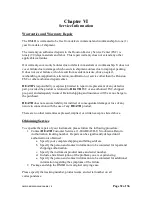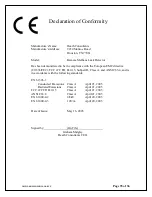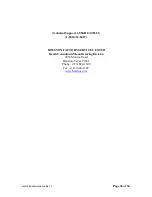
Page 23 of 36
101515-0 RMLD MANUAL REV
F
Chapter IV
Surveying with the RMLD
A training video is provided with the RMLD, which demonstrates the best overview of
techniques used. It is important to learn these techniques in order to properly survey and
locate methane leaks. The purpose of the video is to familiarize a leak surveyor on the
use of the RMLD. It does not provide basic leak survey training. Refer to your
company’s specific training and procedures for being qualified for leak surveying.
In order for the RMLD to detect a gas leak, three conditions must be met:
1. The gas plume concentration and size must be greater than the minimum
sensitivity of the instrument.
2. The IR beam must pass through the plume.
3. The background target (i.e., ground, building, etc.) has to reflect the IR beam
back.
Several factors influence the gas plume size and concentration. First, very low flowing
leaks may produce small to non-measurable plumes. Also, surface types such as concrete
will spread the leak and create spot leaks through surface cracks and holes. Weather
conditions like high winds and higher temperatures will cause the plume to dissipate
faster. The operator must consider these factors and their effects throughout the survey.
The most important aspect to using the RMLD is the proper control and aiming of the IR
beam.
The first thing you will need to learn when surveying with the RMLD is to control the
aiming of the laser and rate of sweeping. Radical or abrupt motion may cause the RMLD
to give false detections due to rapidly changing distance or background that the laser
detects. Radical or abrupt motion may cause the IR beam to not thoroughly scan the area.
Here are a few tips for
surveying along the main
:
•
Use a smooth sweeping motion.
•
Keep the beam pointed out 15 to 20 ft. This allows for the beam footprint on the
ground to be large enough to provide good coverage, and control over the path of
the beam.
•
Scan service tap and valve areas as you approach them.
•
Target probable vent locations such as cracks, vegetation damage, etc.
While scanning the service line/meter where the location is known, keep these tips in
mind:
•
Use the advantage of the beam by sweeping wider around the line location.
•
Work the beam up the line in an “S” pattern.
•
Scan the meter area.
•
Rescan down the line using the “S” pattern.















































